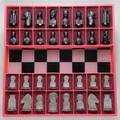Historical Chessboards – Board Games & Decorative Arts)Museum of Decorative Arts in Prague, ulice 17. listopadu 2, Prague 1 April 19, 2018 - September 12, 2018
http://www.upm.cz/index.php?language=en&page=123&year=2018&id=326&img=
The history of board games can be traced back to the ancient high civilizations. Generally, they are characterized by a geometrically structured board surface and playing pieces – simple stones or variously designed figures. The oldest board game still played today is the Asian game of Go. However, chess holds an exclusive place among board games and is recognized as “the royal game” that evolved over many centuries, from the venerable cultures of India and the East (Orient) to medieval Europe. Despite its thousand-year history, chess continues to be a popular board game worldwide and a socially fully respected discipline. a
Chess is believed to have originated in India in the 6th century A.D. There, the game (Sanskrit name chaturanga) received its principal features that consisted of a game board divided into square fields and pieces of varying importance that were formally inspired by military capacities and fortifications structures. In the following century, the Persians adopted the game (under the local term chatrang or shatranj), introducing into the form of the playing pieces a modification with elements of ruling court hierarchy. The term Shah designating the key piece gave this game its permanent name.
In the 10th century, the game was disseminated via the Islamic countries and the Byzantium further on to Europe. For its contacts with the Orient, the first centres where the game of chess was played were, naturally, Italy and Spain. The European ruling courts changed the stylization of the pieces and their names. This is when the square fields of the chessboard received their two contrasting colours. The characteristic chequered design entered the visual arts and heraldry as a distinctive decorative pattern. In Bohemia, acquaintance with the game of chess is documented from the 11th century. The oldest treatise on chess was authored by Tomáš Štítný of Štítný and dates from the late 14th century.
The game of chess was rapidly incorporated into European court culture, where it gained popularity from the 15th century as “the royal game” and a game of the noble and the learned. General interest in chess was disseminated through scholarly texts (the oldest printed book devoted to chess was published in Augsburg in 1472), and the first chess societies and tournaments emerged. During this period, the game’s rules were standardized, establishing the rudiments of the modern game of chess.
The 64 squares were a bloodless arena where the intellectual capacities and strategic planning of the two players were refined (with the aim of maneuvering the opponent’s most important piece – the king – into a loosing position called checkmate). Interestingly, the archaic languages of bygone days used etymologically identical expressions for “battle” and “game”.
Trictrac is also one of the oldest and most widely popular board games; its bizarre name is of Arabic origin (a variant of the English game of Backgammon, the Czech name vrchcáby derives from the German Wurfzabel, devised from the combination of the words derf Wurf – throw, throwing and Zabel – die Tafel – meaning board, table, from the Latin tabula). Trictrac combines a strategic game of two players with an element of chance. The game board is divided into an inner and outer board, each with six wedge-shaped fields of contrasting colours. The players use fifteen dark and fifteen light stones that they move along the fields depending on the how the two dice are thrown. The aim is to place all the player’s stones in the respective inner field and then remove them from the board. In the Middle Ages, the game spread from the Middle and Near East to Europe. In Bohemia, the game of Wurfzabel-vrhcáby was played from the late 10th and early 11th centuries, which fact is documented in archaeological finds.
Museum of Decorative Arts in Prague
|


